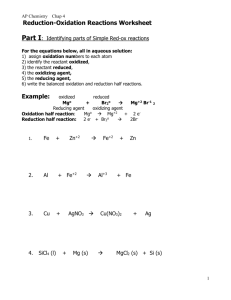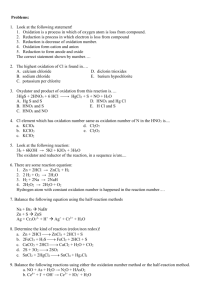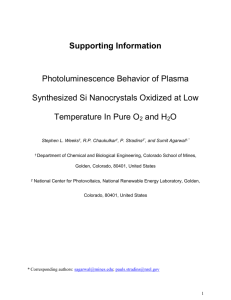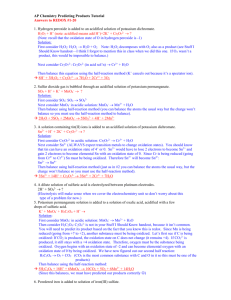Balancing Redox Equations Worksheet - High School Chemistry
advertisement
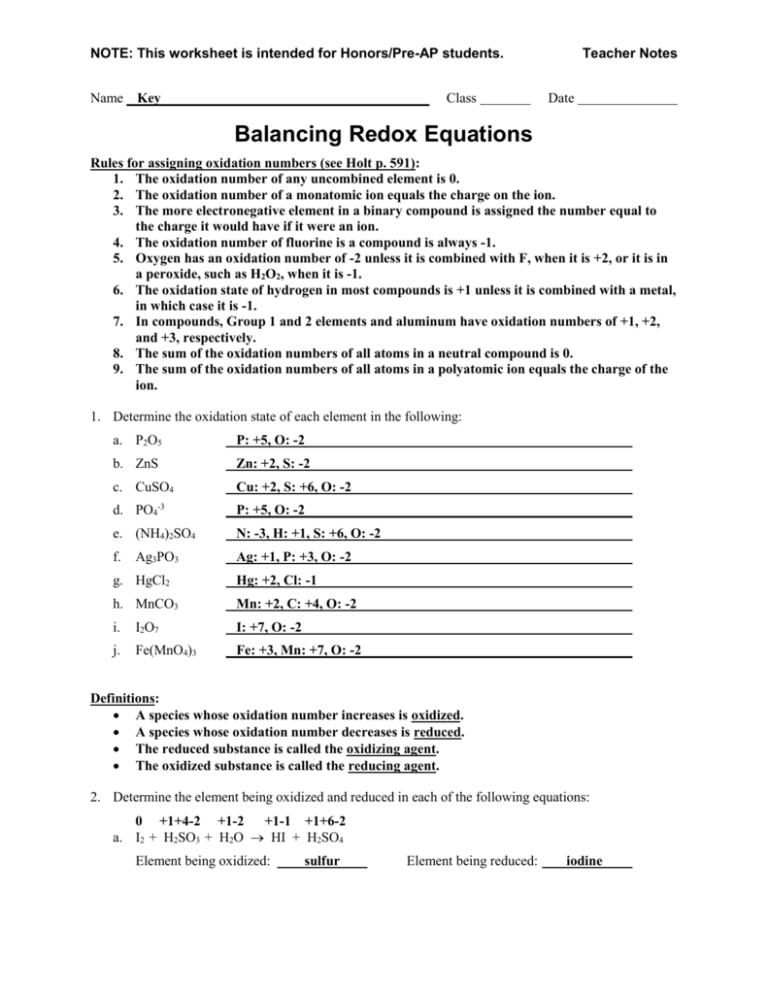
NOTE: This worksheet is intended for Honors/Pre-AP students. Name Key Class Teacher Notes Date Balancing Redox Equations Rules for assigning oxidation numbers (see Holt p. 591): 1. The oxidation number of any uncombined element is 0. 2. The oxidation number of a monatomic ion equals the charge on the ion. 3. The more electronegative element in a binary compound is assigned the number equal to the charge it would have if it were an ion. 4. The oxidation number of fluorine is a compound is always -1. 5. Oxygen has an oxidation number of -2 unless it is combined with F, when it is +2, or it is in a peroxide, such as H2O2, when it is -1. 6. The oxidation state of hydrogen in most compounds is +1 unless it is combined with a metal, in which case it is -1. 7. In compounds, Group 1 and 2 elements and aluminum have oxidation numbers of +1, +2, and +3, respectively. 8. The sum of the oxidation numbers of all atoms in a neutral compound is 0. 9. The sum of the oxidation numbers of all atoms in a polyatomic ion equals the charge of the ion. 1. Determine the oxidation state of each element in the following: a. P2O5 P: +5, O: -2 b. ZnS Zn: +2, S: -2 c. CuSO4 Cu: +2, S: +6, O: -2 d. PO4-3 P: +5, O: -2 e. (NH4)2SO4 N: -3, H: +1, S: +6, O: -2 f. Ag: +1, P: +3, O: -2 Ag3PO3 g. HgCl2 Hg: +2, Cl: -1 h. MnCO3 Mn: +2, C: +4, O: -2 i. I2O7 I: +7, O: -2 j. Fe(MnO4)3 Fe: +3, Mn: +7, O: -2 Definitions: A species whose oxidation number increases is oxidized. A species whose oxidation number decreases is reduced. The reduced substance is called the oxidizing agent. The oxidized substance is called the reducing agent. 2. Determine the element being oxidized and reduced in each of the following equations: 0 +1+4-2 +1-2 +1-1 +1+6-2 a. I2 + H2SO3 + H2O HI + H2SO4 Element being oxidized: sulfur Element being reduced: iodine NOTE: This worksheet is intended for Honors/Pre-AP students. Teacher Notes 0 +1+5-2 +1-2+1 +1-2 +1+3-2 -3+1 b. Al + NaNO3 +NaOH + H2O NaAlO2 + NH3 Element being oxidized: aluminum Element being reduced: nitrogen +1-1 +1+6-2 +1-1 +3-1 +1-1 +1-2 0 c. KI + K2Cr2O7 + HCl CrCl3 + KCl + H2O + I2 Element being oxidized: iodine Element being reduced: chromium 3. Determine the element being oxidized, the element being reduced, the oxidizing agent and reducing agent in each of the following equations: +4-2 +1-1 0 +2-1 +1-2 a. MnO2 + HCl Cl2 + MnCl2 + H2O Element being oxidized: chlorine Oxidizing agent: MnO2 Element being reduced: manganese Reducing agent: HCl +1+6-2 +1-1 +1+5-2 0 +3+5-2 +1+5-2 +1-2 b. K2Cr2O7 + KI + H3PO4 I2 + CrPO4 + K3PO4 + H2O Element being oxidized: iodine Oxidizing agent: K2Cr2O7 Element being reduced: chromium Reducing agent: KI Half-Reaction Method for balancing Redox Equations (see Holt p. 597 - 599): 1. Write the formula equation if it is not given in the problem. Then write the ionic equation. 2. Assign oxidation numbers. Delete substances containing only elements that do not change oxidation state. 3. Write the half-reaction for oxidation. a. Balance the atoms – To balance oxygen, use H2O and H+. In a basic solution, use H2O and OH–. b. Balance the charge – Add electrons to the side with the greater positive net charge. 4. Write the half-reaction for reduction. Balance the atoms and charge. 5. Conserve charge by adjusting the coefficients in front of the electrons so that the number of electrons lost in oxidation equals the number of electrons gained in reduction. Multiply each half-reaction by the coefficient needed to obtain the “lowest common denominator” of electrons. 6. Combine the half-reactions and cancel out anything common to both sides of the equation. 7. Combine ions to form the compounds shown in the original formula equation. Check to see that all atoms balance. 4. Balance the following using the half-reaction method. Be NEAT and METHODICAL. a. AgCN + K KCN + Ag +1 +2-3 0 +1 +2-3 0 Ag+ + CN– + K K+ + CN– + Ag 1(K K+ + e–) 1(Ag + + e– Ag) K + Ag+ + e– K+ + Ag + e– K + AgCN KCN + Ag NOTE: This worksheet is intended for Honors/Pre-AP students. Teacher Notes b. Sn + HNO3 + H2O H2SnO3 + NO 0 +1 +5-2 +1-2 +1 +4-2 +2-2 + – Sn + H + NO3 + H2O 2H+ + SnO32– + NO 3(Sn + 3H2O SnO32– + 6H+ + 4e–) 4(NO3– + 4H+ + 3e– NO + 2H2O) 3Sn + 9H2O + 4NO3– + 16H+ + 12e– 3SnO32– + 18H+ + 12e– + 4NO + 8H2O 1 2 3Sn + H2O + 4NO3– 3SnO32– + 2H+ + 4NO 3Sn + H2O + 4HNO3 3H2SnO3 + 4NO c. NiS + HNO3 Ni(NO3)2 + NO + S + H2O +2 -2 +1 +5-2 +2 +5-2 +2-2 0 +1-2 Ni2+ + S2– + H+ + NO3– Ni2+ + 2NO3– + NO + S + H2O 3(S2– S + 2e–) – + 2(3NO3 + 4H + 3e– 2NO3– + NO + 2H2O) 2– 3S + 6NO3– + 8H+ + 6e– 3S + 6e– + 4NO3– + 2NO + 4H2O 2 3S2– + 2NO3– + 8H+ 3S + 2NO + 4H2O 3NiS + 8HNO3 3S + 2NO + 4H2O + 3Ni(NO3)2 d. Na + S Na2S 0 0 +1 -2 Na + S 2Na+ + S2– 1(2Na 2Na+ + 2e–) 1(S + 2e– S2–) 2Na + S + 2e– 2Na+ + 2e– + S2– 2Na + S Na2S e. K2Cr2O7 + HCl KCl + CrCl3 + H2O + Cl2 +1 +6-2 +1 -1 +1 -1 +3 -1 +1-2 0 2K+ + Cr2O72– + H+ + Cl– K+ + Cl– + Cr3+ + 3Cl– + H2O + Cl2 3(6Cl– Cl– + 3Cl– + Cl2 + 2e–) 1(Cr2O72– + 14H+ + 6e– 2Cr3+ + 7H2O) 18Cl– + Cr2O72– + 14H+ + 6e– 3Cl– + 9Cl– + 3Cl2 + 6e– + 2Cr3+ + 7H2O 6 K2Cr2O7 + 14HCl 3Cl2 + 2CrCl3 + 7H2O + 2KCl

